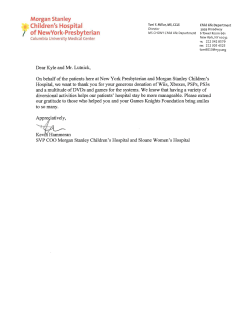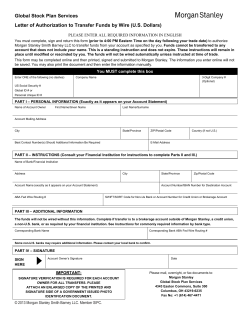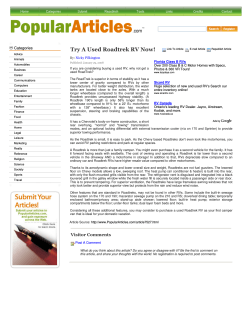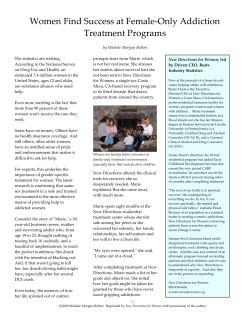
Morgan Stanley And Its Core Carriers
Case Study Morgan Stanley And Its Core Carriers Automate Agent Licensing and Appointment Processing with the LNA Solution from DTCC Distributors and Carriers Realize the Cost and Risk‑Reduction Benefits of Automated Processing: h Up to seven–day reduction in cycle time hReduction of 80% of full–time staff devoted to manual processing h Reallocation of staff to new product areas h Enhanced agent and customer experience DTCC Insurance & Retirement Services Connecting the Industry About DTCC Insurance & Retirement Services DTCC Insurance & Retirement Services is the central messaging hub for annuity transactions and a partner and leader with the insurance industry in the effort to automate, standardize and centralize the processing, monitoring and reporting of insurance products. Insurance & Retirement Services connects the insurance industry through the world’s largest post-trade infrastructure with processing solutions for data exchange and money settlement between product manufacturers and distributors. Insurance & Retirement Services are provided by DTCC’s National Securities Clearing Corporation (NSCC) subsidiary. For more information, visit www.dtcc.com/products/insurance. C a s e St u dy Morgan Stanley and Its Core Carriers Automate Agent Licensing and Appointment Processing with the LNA Solution from DTCC Insurance & Retirement Services W The Case for Automation ith $736 billion in assets under management and more than 600 offices in 35 countries as of August 31, 2008, Morgan Stanley understands that the effec- tive allocation of finite IT resources is a challenging part of business planning. Morgan Stanley’s Annuity & Insurance Services Operations division has demonstrated that targeting technology to automate errorprone, manual processes can drive down the cost of back–office operations, creating efficiencies and improving the customer experience. 1 C A S E S T U D Y : L N A S O L U T I O N F R O M D T C C “The inherent inefficiencies of our manual system were magnified as volume for processing of agent licenses and appointments increased…” appointments were processed manually by staff, consuming approximately 55% of their time. At least 70% of the appointments were renewals. Removing this processing burden of assembling paperwork, updating weekly spreadsheets, faxing and phoning would reduce costs and allow resources to be reallocated. Appointments of agents are required for distributors to transact business with their carriers. At the time of the study, however, only five of 13 of Morgan Stanley’s core insurance carriers utilized LNA for new appointments. In addition, all renewals were done manually by Morgan Stanley and the carriers. Appointments automation presented both an internal and external challenge for Morgan Stanley’s Insurance Operations. “The agents who sell products were directly affected by the delays and the decline in data quality,” said Elora Basu, Morgan Stanley, Insurance Licensing manager. “They were the first to notice errors and would find it difficult to process requests and corrections. With other financial products competing for the attention of financial advisors, it was critical to improve the agent experience in selling insurance products.” Identifying an Opportunity In 2005, Morgan Stanley saw an opportunity to automate the processing of information involved in licensing and appointments of representatives to sell insurance products in individual states. A reengineering analysis by IBM identified savings that could be produced by implementing the Licensing & Appointments (LNA) solution from DTCC Insurance & Retirement Services. DTCC (Depository Trust & Clearing Corporation) partners with the insurance industry to reduce the costs and risk associated with manual operations by automating processes and providing a core connection for carriers, distributors and other trading partners. The LNA solution automates the two-way flow of information, between carriers and distributors, needed to manage the process associated with state licensing and carrier appointment of agents. The business case for automation at Morgan Stanley revealed a considerable manual processing burden subject to errors and delays. “The inherent inefficiencies of our manual system were magnified as volume for processing of agent licenses and appointments increased to somewhere between 1500 and 1700 per month,” said James Boyle, Morgan Stanley, executive director, Annuity & Insurance Services. “A single appointment could take eight to ten days to process and data quality declined.” Developing the Strategy Morgan Stanley determined that a full LNA implementation would expand new appointments automation beyond the initial five carriers to all of Morgan Stanley’s core carriers, as well as automate appointment renewals with all the core carriers. The Impact of Manual Processing According to the study, about 85% of all carrier 2 C A S E S T U D Y : L N A S O L U T I O N James Boyle pointed out that the potential operational savings, enhanced financial advisor experience, shorter cycle times and improved data quality justified the IT resource commitment. “Although speed–to–market is important, the 12-to-18-month timeframe required for full implementation gave us the opportunity to reduce our internal manual renewals and add some real efficiencies for ourselves and our carriers,” he added. F R O M D T C C printing, faxing and follow-up should be eliminated. While phase three is expected to generate the greatest ROI, savings and efficiencies were already apparent after the completion of phase two. The manual processing for just the three carriers in the first two FTE Savings from First Two Phases of LNA Automation The LNA Implementation Working with the DTCC project team, Morgan Stanley’s operations staff formulated a pilot strategy that involved two development tracks: externally automating all of the 13 core carriers for new and renewal appointments, and, simultaneously, internally automating the renewal process at Morgan Stanley. In the first phase (October 2007), Morgan Stanley worked with the carriers collaboratively to develop detailed scenarios, choose data and set up test events. As the project moved to the next phase (January 2008) and best practices were identified, the approach changed. “We decided to streamline the next implementation phase by taking the best elements of both initial pilots and creating the basic scenarios ourselves,” said Dave Barilletto, Morgan Stanley, Global Infra Solutions, Operations. “What had taken three to four weeks in the first phase was reduced to about two weeks in the second phase.” With the completion of the third phase, bringing the rest of the carriers on board, all the manual h Total FTE’s Required phases of LNA implementation originally required the efforts of five full–time employees. With LNA automation, that staff commitment was reduced to one full–time employee (FTE). Morgan Stanley has been able to reallocate these personnel resources to support other business needs such as life insurance. More staff resources are available for reallocation as more carriers are automated. 3 C A S E S T U D Y : L N A S O L U T I O N F R O M D T C C “The positive effect of LNA on the financial advisor experience is at the top of our list of immediate benefits.” beginning to plan the task, along with the solid documentation from Morgan Stanley and Sun Life Financial, led to a smooth implementation process,” said Suzanne Sager, Sun Life Financial, assistant vice president, Broker Dealer Services. She also cited the flexible functionality of LNA and the solid follow-up that the teams provided as major factors in the impressive speed-to-market for the service at her firm. Even for the largest companies, producing solid results on time and on budget is a major factor in justifying the allocation of limited technology resources. Benefits Already Significant “For the carriers that are now fully automated, an appointment process that once took us eight to ten days to complete has now been reduced to three through electronic processing,” said Elora Basu. “Nearly all the human interventions have been eliminated, significantly reducing full–time staff commitment to processing. Carriers and distributors now share highquality data in real time with minimum delays and minor data errors that can be easily identified and quickly corrected.” According to Lana Macumber, DTCC, director, Strategy and Business Development, Insurance & Retirement Services, “Working with Morgan Stanley on LNA provided us with an opportunity to expand usage of an important service while connecting more carriers through our automated solutions. The introduction of LNA AccessSM, our new web-based, front-end application, grew out of our experiences with LNA implementation and the need to provide distributors with easier access to LNA capabilities.” The Benefits are Real and Immediate According to Sager, the standard turnaround time for paper appointment requests was four days, and now with LNA it takes place in real time. “The positive effect of LNA on the financial advisor experience is at the top of our list of immediate benefits. That improves the customer experience and expedites the processing of new business.” Immediately upon link-up, Sun Life Financial discovered lots of capabilities in LNA, and the potential for building on its functionality presents a real opportunity going forward. “The arrival of LNA Access is a real plus. It makes the appointment information more accessible to agents,” added Sager. LNA Access gives distributors and carriers direct access to the capabilities of the full LNA solution. For information on LNA visit www.dtcc.com/products/insurance or call your relationship manager. Sun Life Financial—The Carrier Perspective Sun Life Financial came on board with LNA in phase two of the Morgan Stanley implementation in January 2008. It began with meetings of the respective project managers and teams. Morgan Stanley supplied documentation, Sun Life Financial prepared an implementation guide, which was reviewed by both firms, and then a task plan was defined. “Getting the right people in the room from the 4 Special thanks to our case study contributors: James Boyle, Morgan Stanley, executive director, Annuity & Insurance Services Elora Basu, Morgan Stanley, Insurance Licensing manager Dave Barilletto, Morgan Stanley, Global Infra Solutions, Operations Suzanne Sager, Sun Life Financial, assistant vice president, Broker Dealer Services The Depository Trust & Clearing Corporation (DTCC) The Depository Trust & Clearing Corporation (DTCC), through its subsidiaries, provides clearance, settlement and information services for equities, corporate and municipal bonds, government and mortgage-backed securities and over-the-counter derivatives. In addition, DTCC is a leading processor of mutual funds and insurance transactions, linking funds and carriers with their distribution networks. DTCC’s depository provides custody and asset servicing for 3.5 million securities issues from the United States and 110 other countries and territories, valued at $40 trillion. DTCC settles more than $1.8 quadrillion in securities transactions annually. DTCC has operating facilities in multiple locations in the United States and overseas. For more information, visit www.dtcc.com. We may provide you with additional information about our products and services from time to time. If at any time you wish to be removed from our distribution list, please send and e-mail to PrivacyOffice@dtcc.com www.dtcc.com
© Copyright 2025













